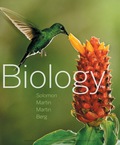
Concept explainers
Introduction:
Answer to Problem 1TYU
Correct answer: Fungi come under the clade opisthokonts that comes under the super group unikonts. Hence, the correct answer is option (a).
Explanation of Solution
Reason for the correct answer:
Opisthokonts are eukaryotes that include fungi as well as animals. Evidence such as movement using a single flagellum that is posterior in position and presence of plate-like cristae in the mitochondria verifies the hypothesis that put forward by systematists. In this hypothesis, systematists categorize fungi into opisthokonts.
Option (a) is given as “fungi are eukaryotes and opisthokonts”.
Fungi are categorized as eukaryotes and opisthokonts. Hence, the correct answer is option (a).
Reasons for incorrect answers:
Option (b) is given as, “fungi are prokaryotes and opisthokonts”.
Fungi are not prokaryotic organisms. Hence, option (b) is incorrect.
Option (c) is given as, “fungi are flagellate and dikaryotic”.
During sexual reproduction in fungi karyogamy takes place to form the new zygote. Thus, they do not remain dikaryotic. Hence, option (c) is incorrect.
Option (d) is given as, “fungi are autotrophic eukaryotes”.
Fungi are eukaryotic organisms but they are not autotrophic. They depend on other organisms for food. Hence, option (d) is incorrect.
Option (e) is given as, “fungi are heterotrophs with cellulose cell walls”.
Fungi are heterotrophic but their cell wall contains chitin and not cellulose. Hence, option (e) is incorrect.
Hence, the options (b), (c), (d), and option (e) are incorrect.
Fungi are eukaryotic organisms that are more closely related to animals compared to plants and are placed in opisthokonts category.
Want to see more full solutions like this?
Chapter 29 Solutions
EBK BIOLOGY
- Test Your Understanding 1. Which of the following is not true of the protists? (a) they are unicellular, colonial, coenocytic, or simple multicellular organisms (b) their cilia and flagella have a 9 + 2 arrangement of microtubules (c) they are prokaryotic, as bacteria and archaea are (d) some are free-living, and some are endosymbionts (e) most are aquatic and live in the ocean or in freshwater pondsarrow_forward1. We know fungi are eukaryotic (have membrane-bound nuclei and organelles). Explain three unique ways fungi are different from other microbes (algae, protozoans, bacteria, and archaea). Compare cell walls, cell membranes, morphology, reproduction, and life cycles. (Words to use in your answer include chitin, cellulose, peptidoglycan, pseudopeptidoglycan, ergosterol, hopanoids, cholesterol, mycelium, hyphae, multinucleate, multicellular, unicellular, nutritional needs, environmental needs, chemoheterotrophy, saprobes, parasites, free-living, reproductive strategies, spores). 2. Algae and protozoans are loosely grouped as protists and are different from plants because they lack specific characteristics of plants. Explain what differentiates algae from plants and two ways they are different from protozoans. Talk about algae being part of our environment and how algae may positively or negatively impact our health or the environment. (Words to use in your answer: cell wall, cell membrane,…arrow_forwardPhotosynthetic protists with shells composed of two halves that fit together like a petri dish are (a) golden algae (b) diatoms (c) euglenoids (d) brown algae (e) foramsarrow_forward
- Give an example of a protist that is:(a) a parasite of humans(b) very large and photosynthetic(c) a unicellular species with two flagella and photosynthetic(d) covered in ciliaarrow_forwardFungi are not classified in the Kingdom Plantae primarilybecause they:(a) Have unicellular and (d) Need high moisturemulticellular forms (e) Reproduce sexually(b) Are prokaryotes(c) Are heterotrophsarrow_forwardMembers of the kingdom Protista differ from members ofthe kingdom Monera mainly due to the presence of:(a) RNA(b) Ribosomes(c) Cell wall(d) DNA(e) Membrane-bound nucleusarrow_forward
- Protists are(a) single-celled eukaryotes.(b) multicellular eukaryotes.(c) single-celled prokaryotes.(d) single-celled akaryote. Please try to break the solutions into as many steps as practically possible and the steps should come one by one and they should be short and crisp and plagiarism-free.arrow_forwardBacteria that are autotrophs (a) do not require atmospheric oxygen for cellular respiration (b) must obtain organic compounds from other organisms (c) manufacture their own organic molecules from simple raw materials (d) get their nourishment from dead organisms (e) produce endospores when oxygen levels are too low for active growtharrow_forwardWhich of the following involves metabolic cooperation among prokaryotic cells? (A) binary fission (B) endospore formation (C) biofilms (D) photoautotrophyarrow_forward
- Match the following microorganisms with the descriptionthat best applies:Algae (a) Multicellular nucleated microorgan-Bacteria isms that have branching filamentsFungi (b) Acellular entities that require aProtozoa host for multiplicationViruses (c) Photosynthetic large cells thatHelminthes rarely cause human disease(d) Parasitic worms(e) Large, single-celled nucleated mi-croorganisms(f) Single-celled non-nucleated micro-organismsarrow_forwardFungal structures: Which of the following are true? 1. cell walls contain chiten 2. cell walls contain cellulose 3. no cell walls 4. cell walls contain peptidoglycan 5. cell membranes contain cholesterol 6. cell mebranes contain ergosterol 7. contain a nuclues 8. lack a nucelus 9. contain mitochonfria 10. lack mitochondria O 1, 6, 7,9 O 2, 4, 6, 8, 10 O 1, 3, 5, 7, 9 O 1, 4, 7,9arrow_forwardWe know fungi are eukaryotic (have membrane-bound nucleus and organelles). Explain three unique ways fungi are different from other microbes (algae, protozoans, bacteria and archaea). Compare things like cell walls, cell membranes, morphology, reproduction, life cycles. (Words to use in your answer include chitin, cellulose, peptidoglycan, pseudopeptidoglycan, ergosterol, hopanoids, cholesterol,mycelium, hyphae, multinucleate, multicellular, unicellular, nutritional needs, environmental needs, chemoheterotrophy, saprobes, parasites, free-living, reproductive strategies, spores).arrow_forward
 Biology (MindTap Course List)BiologyISBN:9781337392938Author:Eldra Solomon, Charles Martin, Diana W. Martin, Linda R. BergPublisher:Cengage Learning
Biology (MindTap Course List)BiologyISBN:9781337392938Author:Eldra Solomon, Charles Martin, Diana W. Martin, Linda R. BergPublisher:Cengage Learning
